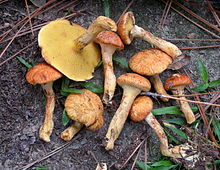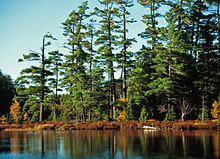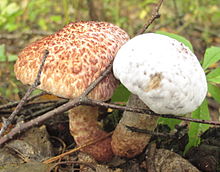Suillus spraguei
| Suillus spraguei | |
|---|---|

| |
| Found in New Hampshire, US | |
| Scientific classification | |
| Domain: | Eukaryota |
| Kingdom: | Fungi |
| Division: | Basidiomycota |
| Class: | Agaricomycetes |
| Order: | Boletales |
| Family: | Suillaceae |
| Genus: | Suillus |
| Species: | S. spraguei
|
| Binomial name | |
| Suillus spraguei | |
| Synonyms[5] | |
| Suillus spraguei mycorrhizal | |
|---|---|
| Edibility is choice | |
Suillus spraguei is a species of fungus in the family Suillaceae. It is known by a variety of common names, including the painted slipperycap, the painted suillus or the red and yellow suillus. Suillus spraguei has had a complex taxonomical history, and is also frequently referred to as Suillus pictus in the literature. The readily identifiable fruit bodies have caps that are dark red when fresh, dry to the touch, and covered with mats of hairs and scales that are separated by yellow cracks. On the underside of the cap are small, yellow, angular pores that become brownish as the mushroom ages. The stalk bears a grayish cottony ring, and is typically covered with soft hairs or scales.
Suillus spraguei grows in a
Taxonomy, phylogeny, and naming
Suillus spraguei has had a complex
| Phylogeny and relationships of S. spraguei and related species based on ITS sequences[12] |
A 1996
The
Description

The cap of the fruit body is 3 to 12 cm (1.2 to 4.7 in) in diameter, and depending on its age, is either conic to convex, to somewhat flattened at maturity. The cap margin is initially rolled downward before straightening out, often with hanging remnants of partial veil (appendiculate).[19] The cap surface is covered with densely matted filaments that are rough and scale-like. The scales are pink to brownish red, fading to a pale brown-gray or dull yellow in maturity. Under the scales, the cap surface is yellow to pale yellow-orange. While many other Suillus species have a sticky or slimy cap, S. spraguei is dry. The flesh is yellow.[20]
The pores on the underside of the cap are yellowish and angular, measuring 0.5 to 5 mm (0.02 to 0.20 in) wide, and formed by tubes that extend 4 to 8 mm (0.2 to 0.3 in) deep.
In deposit, such as with a
Various parts of the mushroom display characteristic color reactions to chemical tests commonly used in mushroom identification. The cap cuticle will turn a blackish color with the application of a drop of potassium hydroxide (KOH), iron sulfate (FeSO4) solution, or ammonia solution. The mushroom flesh turns grayish-green to greenish black with a drop of FeSO4, and olive to greenish black with KOH or NH4OH.[19]
Edibility
Suillus spraguei is an
Similar species

S. spraguei is a popular edible among novice mushroom hunters as it is readily identifiable due to both its appearance and its association with white pine. This renders it unlikely to be confused with other species,
Ecology, habitat and distribution

In nature, Suillus spraguei forms

A Japanese field study found that S. spraguei was the dominant fungus in a 21-year-old stand of Korean pine, both in terms of ectomycorrhizae (measured as percentage of
Suillus spraguei has a disjunct distribution[38] and is known from several localities in Asia, including China,[39] Japan,[40] Korea,[41] and Taiwan.[42] In North America, its range extends from eastern Canada (Nova Scotia)[20] south to the Carolinas, and west to Minnesota.[19] It has also been collected in Mexico (Coahuila and Durango).[38] Furthermore, the species has been introduced to Europe (Germany, Lower Saxony; Netherlands).[43][44][45][46]
See also
Notes
- ^ According to Streinz (1862), Boletus pictus Schultz is probably the same species as Polyporus perennis (L.) Fr.,[5] currently known as Coltricia perennis.[8]
- ^ Palm and Stewart consider Kuntze responsible for the transfer to Suillus; other authorities, including the taxonomic databases Index Fungorum[9] and MycoBank,[10] instead cite Smith and Thiers' 1964 monograph on North American species of Suillus.[11]
References
- ^ a b Berkeley MJ. (1872). "Notices of North American fungi". Grevillea. 1 (3): 35.
- ^ Peck CH. (1873). "Report of the Botanist (1869)". Annual Report on the New York State Museum of Natural History. 23: 128.
- ^ Kuntze O. (1898). Revisio Genera Plantarum (in German). Vol. 3. Leipzig, Germany: Arthur Felix. p. 535.
- ^ "Boletinus pictus (A.H. Sm. & Thiers) Lj.N. Vassiljeva 1978". MycoBank. International Mycological Association. Retrieved 2010-12-04.
- ^ JSTOR 3793035.
- ^ a b Singer R. (1945). "The Boletineae of Florida with notes on extralimital species II. The Boletaceae (Gyroporoideae)". Farlowia. 2: 223–303.
- JSTOR 3754872.
- ^ "Polyporus perennis (L.) Fr. 1821" (International Mycological Association). MycoBank. Retrieved 2010-12-27.
- ^ "Suillus pictus (Peck) A.H. Sm. & Thiers". Index Fungorum. CAB International. Retrieved 2010-12-29.
- ^ "Suillus pictus A.H. Sm. & Thiers 1964". MycoBank. International Mycological Association. Retrieved 2010-12-29.
- ^ Smith AH, Thiers HD (1964). A Contribution Toward a Monograph of North American Species of Suillus (Boletaceae). p. 31.
- ^ JSTOR 3760972.
- ^ PMID 11020303.
- S2CID 86035482.
- ^ ISBN 0-472-85610-3.
- ^ ISBN 0-395-91090-0.
- ^ ISBN 978-0-271-02891-0.
- ^ ISBN 978-0-472-03126-9.
- ^ a b c d e Bessette et al. (2001), pp. 246–47.
- ^ ISBN 3-7682-1062-6.
- ^ ISBN 0-8131-9039-8.
- ISBN 978-1-58729-627-7.
- ^ ISBN 978-0-7627-3109-1.
- ISBN 978-2-7621-2617-4.
- ^ Given in the source as Fuscoboletinus ochraceoroseus, but this species has since been transferred to the genus Suillus. See Suillus ochraceoroseus at Index Fungorum.
- ISBN 0-89815-169-4.
- ^ Bessette et al. (2001), p. 233.
- ^ Bessette et al. (2001), pp. 242–43.
- ^ Bessette et al. (2001), p. 234.
- ^ doi:10.1139/b86-290.
- .
- JSTOR 3793215.
- .
- ^ Bessette et al. (2001).
- JSTOR 3760079.
- S2CID 27649536.
- JSTOR 1514761.
- ^ The Field Museum. Retrieved 2009-10-02.
- JSTOR 3755085. Archived from the originalon 2015-09-23. Retrieved 2010-12-27.
- ^ Murata Y. (1976). "The boletes of Hokkaido I. Suillus Micheli ex S. F. Gray m. Snell". Transactions of the Mycological Society of Japan. 17: 149–58.
- ISSN 0445-4650.
- ^ Yeh K-W, Chen Z-C (1980). "The boletes of Taiwan (I)" (PDF). Taiwania. 25 (1): 166–84. Archived from the original (PDF) on 2011-07-18.
- ^ Bas C. (1973). "Boletinus pictus, ein amerikanischer Röhrling im Nordwesten Deutschlands gefunden" (PDF). Westfälische Pilzbriefe (in German). 9 (3–5): 45–50.
- ISSN 1430-595X.
- ISSN 0929-7839.
- ^ Arnolds E, Chrispijn R (2011). Paddenstoelen in Nationaal Park Het Drents-Friese Wold 2008–2010. Rapport Paddenstoelen Werkgroep Drenthe (PDF) (in Dutch). Beilen: Paddenstoelen Werkgroep Drenthe. p. 59.
Cited text
- Bessette AE, Roody WC, Bessette AR (2000). Boletes of North America. Syracuse, New York: Syracuse University Press. ISBN 978-0-8156-0588-1.


